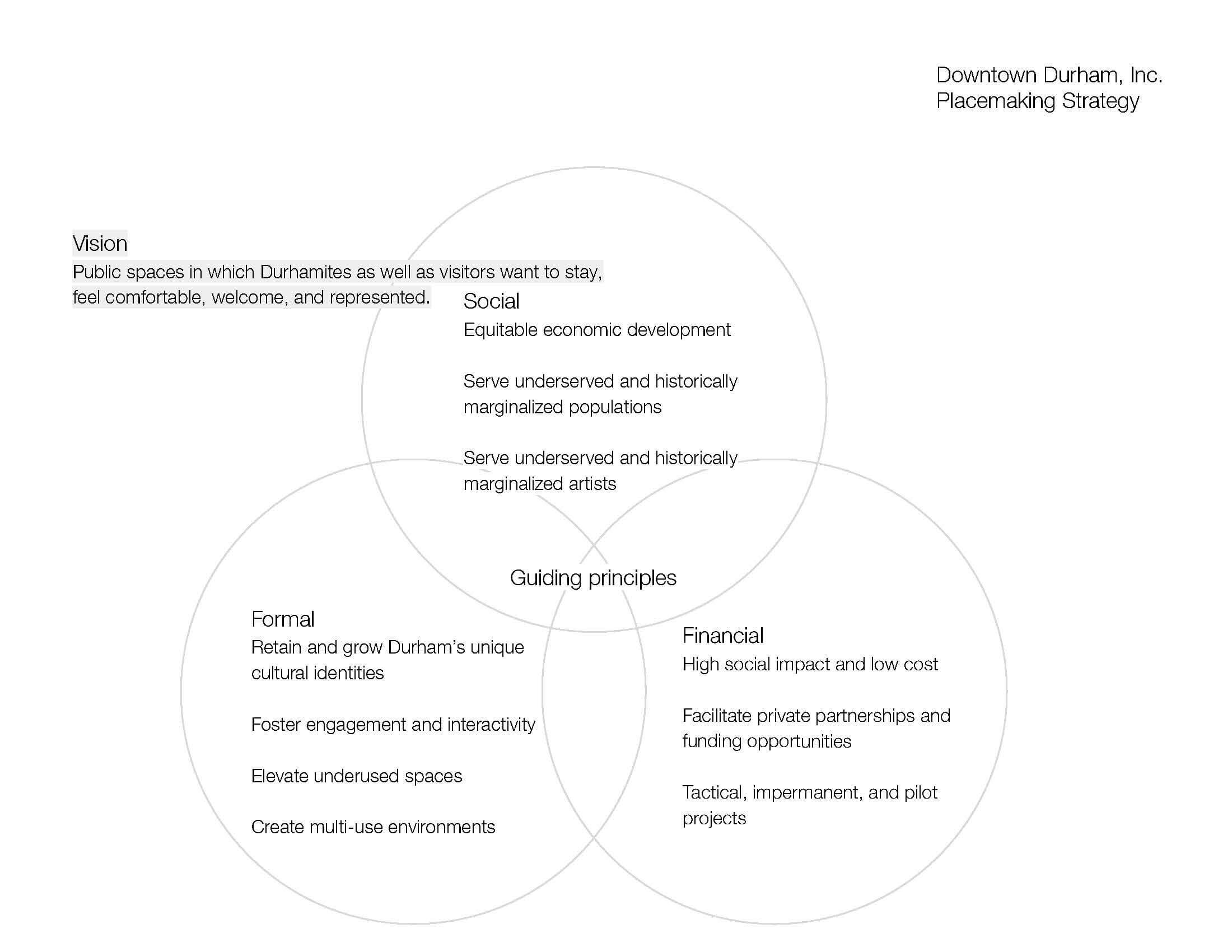Policy: The DDI Placemaking Strategy
was developed to guide Downtown Durham, Inc.’s primary public art and creative placemaking priorities with careful attention paid to the values of the organization and community.
Highlights
Durham’s robust downtown environment hailed a pivot in DDI’s priorities from economic development to an emphasis on local cultural investment.
With this strategy guiding DDI’s creative placemaking activities, within a period of 3 years:
The organization engaged more than 245 local artists;
100% of art funding was directed to Durham/Triangle artists;
58% of funds were distributed to BIPOC artists;
Projects received additional funding from grants and private partnerships;
Projects were acclaimed by the local press, City Council, and the International Downtown Association; and
DDI became established as a leader in local equitable arts programming and the Durham arts community.
Produced for: Downtown Durham, Inc.
Location: Durham, North Carolina
Year: 2018
Role: Author
While the city grows economically, it’s important that DDI and the community at large uphold and nourish our artists and creators who have been integral in making this a city that is loved by newcomers and Durham natives alike.
Nicole Thompson, DDI President/CEO
Context
Downtown Durham, Inc. (DDI) is a non-profit organization facilitating downtown revitalization and economic development through strategy, policy, and business support.
Since DDI’s inception in 1993, Durham’s Downtown district has flourished and added more than 300 new businesses while increasing it’s residential population by nearly ten times, and attracting more than 1 million visitors per year. The organization was formed to facilitate development, but with the robust and thriving environment, the organization grew to prioritize inclusivity and cultural enrichment.
In 2017, DDI identified the need for an internal role dedicated to social and cultural initiatives. Stein joined the organization with a focus on art and placemaking to support DDI’s mission of fostering a vibrant district that highlights cultural diversity and community.
Placemaking, an approach to collectively shaping public space, invites collaboration to infuse the local culture in the urban landscape and facilitate deeper bonds between places and people. It seeks to create an interactive environment that allows people to feel comfortable and welcome in public space.
To support the overall goals of the organization and to refresh it’s priorities and investments, Stein developed DDI’s first Placemaking Strategy to direct its newest efforts.
The project's heartful, inclusive, democratic spirit is a beacon of Durham values at their best… that, with Wexler's help, DDI seems freshly primed to embody.
“DDI’s Public Space Project Is an Audacious, Inclusive New-Durham Turn for a Venerable Old-Durham Nonprofit.” INDY Week, August 2018
DDI Master Plan Goals
The Strategy worked to specifically address Connectivity, Logistics, Diversity, and Design.
Evaluating DDI’s Projects
The impacts of projects in progress were compared to the Strategy’s guiding principles.
Process and Outcomes:
From the project outset, the overall aim and purpose of the inaugural Placemaking Strategy was defined to guide and launch DDI’s public art and creative placemaking activities. The Strategy would be utilized to define the organization’s values and priorities, to focus on projects and collaborations that align with these standards, and to re-evaluate projects that do not.
Referencing the community concerns and goals outlined in the 2016 Downtown Durham Master Plan, the Placemaking Strategy was designed to leverage DDI’s capacities and scope to directly address the needs of the community.
Peer cities’ public art strategies and policies were analyzed and presented for feedback. Various opportunities and interventions were considered in regard to examples of successful initiatives and programs. Key findings and insights were adapted to the local environment, and in consideration of the organization’s role and capacity.
In-depth research regarding urban policy, community aims, and creative trends informed practical and actionable guidelines and metrics. With an evaluation of past, current, and future projects, the Strategy assessed DDI’s roster of placemaking activities in consideration of their ability to address the organization and community’s overall goals. An emphasis was placed on constructive recommendations with sensitivity to relationships with the local culture and partner organizations.
The resulting Placemaking Strategy was adopted by DDI, and presented to the City of Durham’s Public Art Committee and to the City’s Cultural Advisory Board.
By upholding the principles presented in the strategy, DDI has become a leader in the local art ecosystem and positioned itself to advise and collaborate with other organizations undertaking placemaking and art initiatives.
The Strategy continues to guide the organization’s programming and investments in public art and creative placemaking initiatives.
Key guidelines of the strategy include:
Shape public spaces in which locals and visitors want to stay, and feel comfortable, welcome, and represented;
Identify conceptual, community-engaged, and site-specific public art projects
Support equitable economic development;
Serve underserved and historically marginalized populations and artists;
Support projects with a high social impact to cost ratio;
Facilitate partnerships and funding opportunities;
Retain, grow, and represent Durham’s cultural identity;
Elevate underused public spaces; and
Foster engaging, multi-use environments.
Projects Executed Include:
The Mix at Durham Station





![Public Art: Fügung des Schicksals [Twist of Fate]](https://images.squarespace-cdn.com/content/v1/611c4a9feab4d91413c4ae77/65cfd2d0-c30d-436d-982d-5321a56a1dcd/RSteinWexler-F%C3%BCgung-des+Schicksals-Twist-of+Fate.jpg)
![Public Art: Wahlfamilie [Chosen Family]](https://images.squarespace-cdn.com/content/v1/611c4a9feab4d91413c4ae77/656a9772-01f9-4ef2-8bae-2bcc1c87a863/RSteinWexler-Public-Art-Wahlfamilie-Chosen-Family.jpeg)


![Proposal: Willkommenskul[p]tur](https://images.squarespace-cdn.com/content/v1/611c4a9feab4d91413c4ae77/1629617643536-EVZ02Z8DZ7OT9EN54XE0/Stein-Wexler-Willkommenskultur-Public-Art-Proposal-Immigration-Welcome-Culture.jpg)





